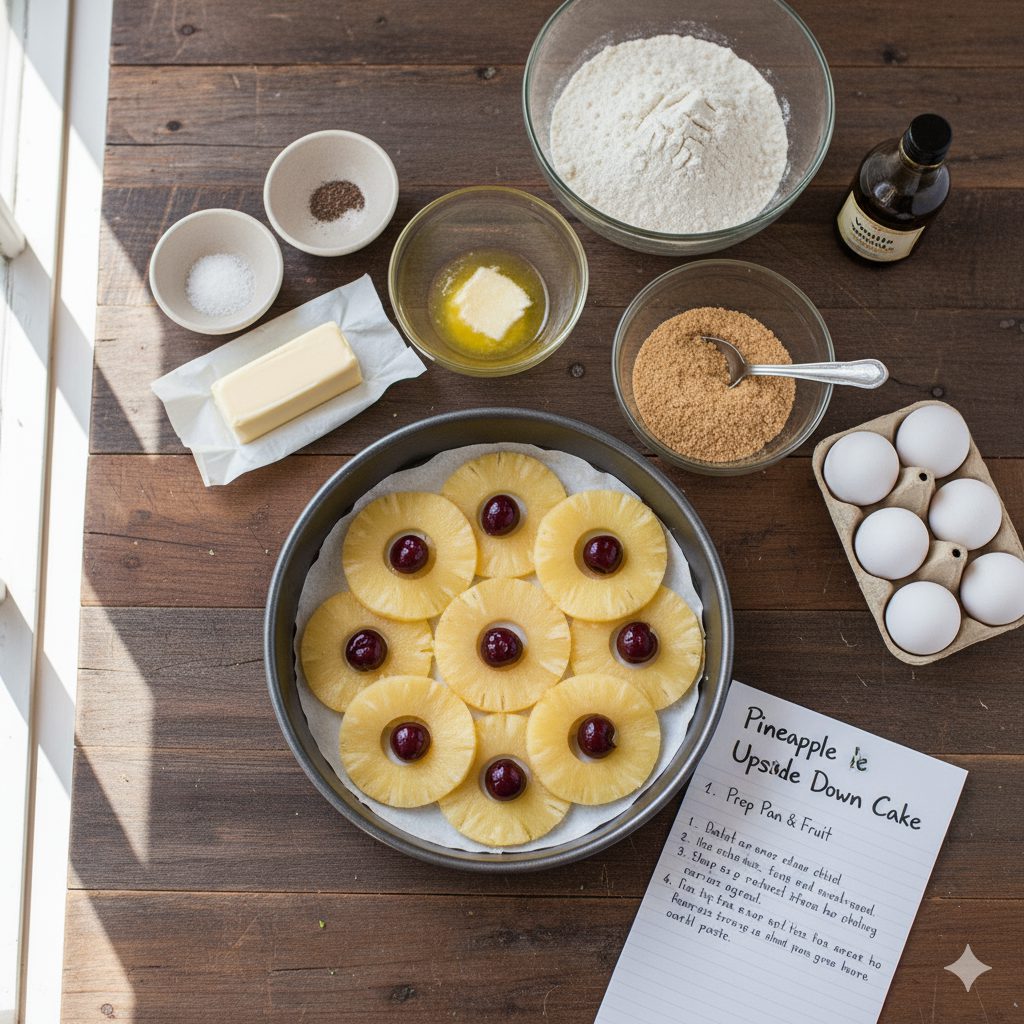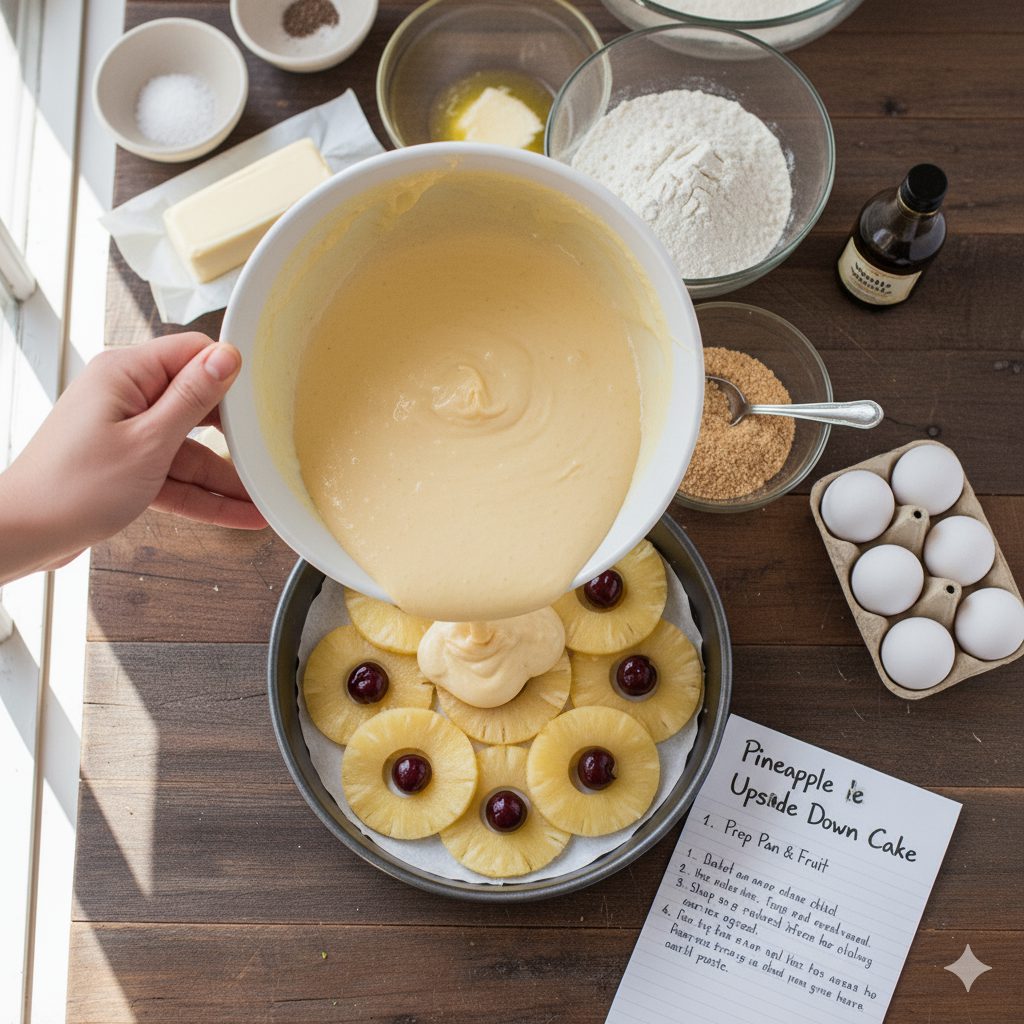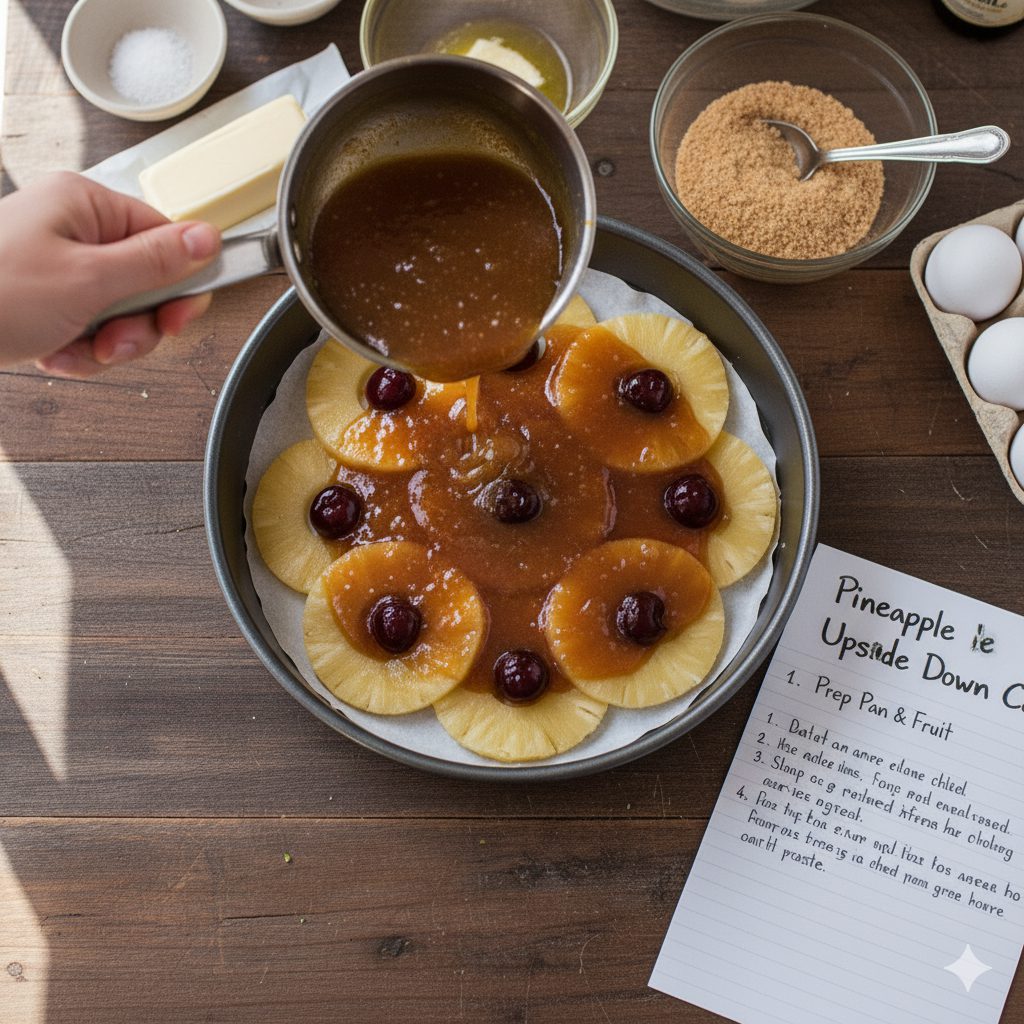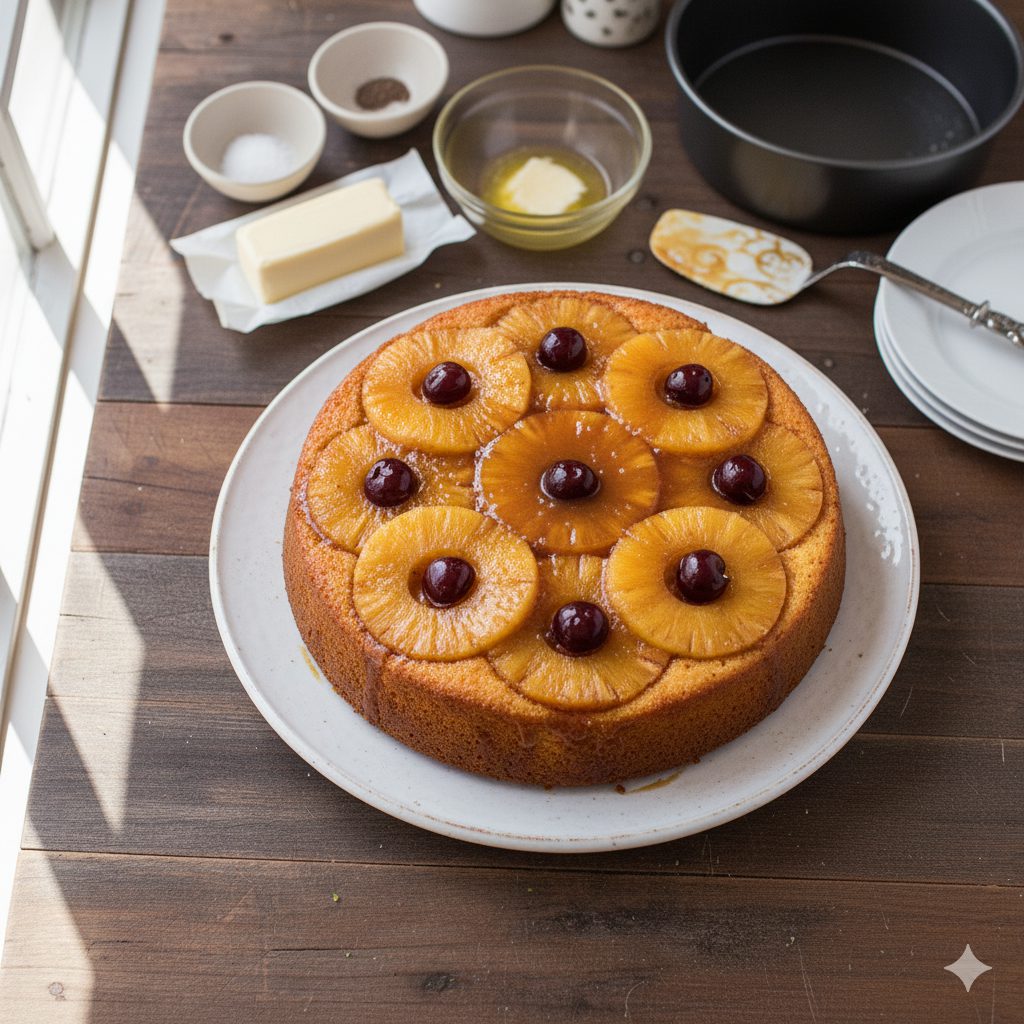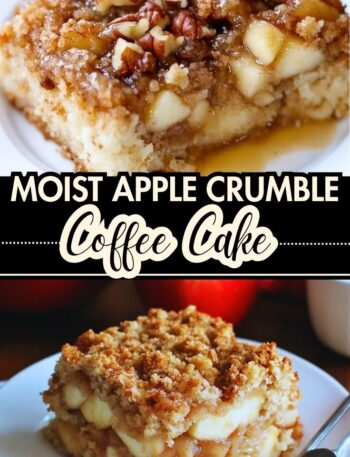
There are some desserts that deserve a permanent place in any recipe collection, and Pineapple Upside Down Cake is one of them. It looks impressive yet is wonderfully simple to make. Golden pineapple slices rest atop a glossy caramel glaze, with a tender cake baking just beneath. Each slice reveals a warm, sticky crown, while bright cherries add color and cheer.
This cake rewards the use of simple ingredients. Butter and brown sugar melt into a luscious base, blending beautifully with the fruit juices to form a rich syrup. The texture is soft and moist, while the top becomes slightly crisp and caramelized. The contrast is nothing short of delightful.
The recipe is forgiving and adaptable. Swap canned for fresh pineapple if you like. Experiment with different cake pans to change the presentation. A splash of vanilla or a touch of rum can add depth and warmth. Serve it at teatime, bring it to a festive table, or enjoy it as a cozy weekend treat—it suits both casual and special occasions.
This dessert is worth saving. The steps are short, the ingredients are common, and the results are always rewarding. Leftovers reheat beautifully and stay moist, carrying the same vintage charm that makes this cake feel both familiar and joyful.
Make it once, and it will quickly become a recipe you return to again and again. Pin this recipe now or note it down so it is easy to find later. Try adding your own touches extra spice, a different pan size, or even roasted fruit. However you make it, this cake will deliver effortless success and plenty of smiles. Save it today and share it with friends; it will always shine when comfort and fruit-filled sweetness are needed most.
Pineapple Upside Down Cake
Description
Pineapple Upside Down Cake is a classic retro dessert known for its caramelized pineapple topping and buttery vanilla cake base.
Baked with slices of pineapple rings (often adorned with maraschino cherries) layered at the bottom of the pan, the cake is flipped after baking to reveal a glossy, golden crown of fruit.
Moist and rich, this nostalgic treat delivers a delightful contrast of sweet, syrupy fruit and tender cake. It’s perfect for gatherings, potlucks, or as a tropical-themed dessert.
Served warm or at room temperature, it brings a sunny twist to traditional cake recipes with every bite.
Ingredients
For the Cake Batter:
Instructions
-
Topping
Melt ¼ cup butter in an oven-safe cake pan or a small saucepan. Sprinkle ½ cup brown sugar evenly over the melted butter. Place six to eight pineapple slices flat in one layer. If you like, put a cherry in the middle of each. Keep to the side.
-
Batter
Combine 1½ cups all-purpose flour, 2 teaspoons baking powder, and ¼ teaspoon salt in a bowl. Whisk until evenly mixed. In a separate bowl, cream ½ cup softened butter with ¾ cup granulated sugar until light and smooth. Add 2 large eggs one by one, stirring after each until it is completely incorporated. Fold in 1 teaspoon vanilla extract. Alternate spoonfuls of the flour mixture and ½ cup milk, beginning and ending with the flour. Pour in 2 tablespoons reserved pineapple juice for extra flavor. Gently mix only until the batter comes together. Do not overmix.
-
Assemble and bake
Gently spoon the batter over the fruit, then level the top. Place the pan in a 350°F (175°C) oven and bake for 40–45 minutes. A toothpick inserted in the center should come out clean. Remove from the oven and let the cake rest for 5 minutes.
-
Finish
Run a knife along the inside edge of the pan to release the cake. Set a serving plate over the top, then flip the pan upside down in one quick motion. Lift the pan off with care. If a piece of fruit stays behind, move it back onto the cake before serving. Let the cake cool until slightly warm. Cut into slices and serve with whipped cream or ice cream if you like.
Nutrition Facts
Servings 10
- Amount Per Serving
- Calories 370kcal
- % Daily Value *
- Total Fat 18g28%
- Saturated Fat 10g50%
- Cholesterol 60mg20%
- Sodium 300mg13%
- Total Carbohydrate 55g19%
- Dietary Fiber 2g8%
- Sugars 35g
- Protein 4g8%
* Percent Daily Values are based on a 2,000 calorie diet. Your daily value may be higher or lower depending on your calorie needs.
Note
Tips and Tricks for Pineapple Upside Down Cake
1. Prepare the Pan Properly
The base of this cake sets the stage for everything. Grease the pan well so the topping releases easily after baking. Arrange pineapple slices neatly in the bottom of the pan for a classic look. Pour melted butter and brown sugar evenly over the fruit to create a caramel glaze.
2. Use the Right Pineapple
Fresh pineapple brings bright flavor, but canned slices are often easier to use. Too much juice makes the cake soggy. Pat the slices dry with paper towels for the best results. Fresh pineapple should be cut evenly so it bakes consistently. Both options work well, but preparation matters. Dry, well-cut pineapple helps the topping stay firm and flavorful.
3. Mix the Batter Carefully
A light and fluffy batter makes the cake tender. Mix in dry ingredients slowly so the batter does not deflate. Fold the batter gently over the fruit layer, spreading it evenly. The right mixing method ensures the cake rises properly and bakes evenly across the pan.
4. Watch the Baking Time
Flip it carefully onto a plate while still warm. Waiting too long makes the sugar harden, and the topping may stick. Timing is key to a perfect flip and presentation.
5. Add Flavor Boosts
Enhance the flavor with small touches. A splash of pineapple juice or vanilla improves sweetness. Toasted coconut can be sprinkled on top after flipping for extra texture. Use high-quality butter for richer caramelization. These little additions elevate the cake from simple to special. Flavor boosters make the dessert memorable without changing its classic appeal.
6. Store and Serve Smartly
This cake tastes best warm but can be stored for later.
Frequently Asked Questions
Why is it called "Upside Down" Cake?
The name comes from the way the cake is baked. Slices of pineapple, cherries, and a brown sugar–butter glaze are placed at the bottom of the cake pan. The cake batter is poured over this layer, and after baking, the whole thing is flipped over (inverted) onto a plate, making the fruit topping visible on top — hence, "upside down."
Can I use fresh pineapple instead of canned?
Yes, you can use fresh pineapple. Just make sure to slice it thinly so it cooks evenly and softens during baking. However, canned pineapple rings are more uniform and often easier to work with, especially in traditional presentations. If using fresh pineapple, consider lightly cooking or soaking it to soften before arranging in the pan.
How do I prevent the topping from sticking to the pan?
Greasing the pan thoroughly is crucial. Use butter or nonstick spray, and ensure the brown sugar and butter mixture is evenly spread at the bottom before adding fruit. You can also line the bottom with parchment paper for extra insurance. Let the cake rest for 5–10 minutes after baking before inverting — not too hot and not too cool.
Can I make Pineapple Upside Down Cake in advance?
Yes, but it's best enjoyed fresh the same day. You can bake it a day ahead and store it (covered) at room temperature. For longer storage, refrigerate and warm it slightly before serving to bring back the moist texture. Avoid freezing it, as the fruit layer may become soggy.


